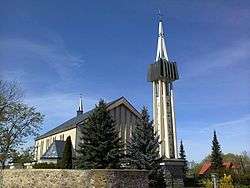Radziłów
Radziłów [raˈd͡ʑiwuf] is a village (formerly a town) in Grajewo County, Podlaskie Voivodeship, in north-eastern Poland. It is the seat of the gmina, an administrative district called Gmina Radziłów. It lies approximately 27 kilometres (17 mi) south of Grajewo and 61 km (38 mi) north-west of the regional capital Białystok. In 2007 the village had a population of 1,267.
Radziłów | |
|---|---|
Village | |
 Church of St. Anne | |
 Radziłów | |
| Coordinates: 53°24′39″N 22°24′36″E | |
| Country | |
| Voivodeship | Podlaskie |
| County | Grajewo |
| Gmina | Radziłów |
| Population | 1,267 |
History
The history of Radziłów is closely connected with the history of Masovia Province from before the Partitions of Poland. The first settlers arrived in the Middle Ages and began clearing the impenetrable forest. Masovian Dukes, who owned the area, issued the rights to enter the forest and harvest it. Among the first settlers were bee-keepers, fishermen, hunters and loggers, who sold honey, wax, fish and lumber to neighboring towns, Wizna and Goniądz. The lumber was also transported via Biebrza and Ełk river waterways to Gdańsk.[1]
The founding of the city took a long time. Radziłów was formally established by Prince Konrad III, with Kazimierz III, Bolesław V and Janusz II, who gave it the city rights on May 9, 1466. The town began to flourish in the 16th century. Located at a trading route between Wizna and Wąsosz, it became a commercial center for bakers, shoemakers, tailors, butchers, blacksmiths, wheelwrights, cooper-makers and potters. The main square in Radziłów at the time (180 m × 120 m in size) was bigger than in Warsaw (70 m × 94 m) and in Płock (140 m × 70 m) and held two weekly markets, on Monday and on Sunday (from 17th century on) as well as a fair on Wednesday added by king Władysław IV in 1641. The majority of inhabitants lived off farming.[1]

During the partitions of Poland, after the suppression of the 1863 January Uprising against Russia, the Tsarist authorities changed the administrative divisions of Congress Poland placing Radziłów in the Łomża province. In 1869 the town was stripped of its town charter and became the village; however the population was steadily increasing due to Russian repressions against Jews some of whom found refuge in the area. The Jewish merchants expanded local trade, established breweries, small craft and various services. Following the rebirth of Poland after World War I, two new public schools were established employing ten teachers, and two Jewish schools.[1]
In 1940, the town had a population of 2,865 people, of which 500 were Jews.[2]
World War II atrocities
The 1937 population of Radziłów was 2,500 including 650 Jews. The Germans entered the town on 7 September 1939, but turned the town over to the Soviet Union at the end of September in accordance with the Molotov–Ribbentrop Pact. On 23 June 1941 the Germans re-occupied the town as part of Operation Barbarossa.[3]
The Germans were greeted with a ceremonial gate, erected by Poles who had been formerly imprisoned by the Soviets, bearing a photograph of Hitler and praising the German army.[4] The Germans appointed Józef Mordasiewicz and Leon Kosmaczewski as heads of the local collaborationist administration. Over the next few weeks the Jews of Radziłów, as well as refugees from other villages who had taken up residence in town, were tormented by the German troops and some Poles. Jews were beaten and robbed, Jewish holy texts were desecrated, Jewish women were raped, and hundreds of Jews were murdered.[3]
On 7 July 1941, the local Poles forced most of the Jews into a barn and set it on fire. People attempting to escape were shot, and Jews caught outside were thrown into the flames. Those Jews who managed to survive were hunted over the next three days.[3] Jews from neighboring villages were not taken to the barn, but rather murdered on the spot.[4] Death toll estimates vary from 600 to 2,000, but only about 30 Jews survived with help from local Poles.[3]
The remaining Jews were interned in a small ghetto from August 1941. On 1 June 1942 most of the ghetto inmates were deported to labor on the Milbo estate. On 2 November the Jews deported to Milbo were deported to a transit camp in the village of Bogusze. From there they were sent to Treblinka extermination camp and murdered on arrival. Approximately nine Jews survived the war hiding in villages around Radziłów.[3] On 28 January 1945 (five days after Soviet forces liberated the town), local Poles murdered two Jews who had survived in hiding.[5][6][3]
Eight local Polish perpetrators were tried in Polish courts after the war. Hermann Schaper, whose SS unit was involved in some of the atrocities in Radziłów, was tried in Germany in 1976 for other crimes against Poles and Jews and was sentenced to six years in prison, however following an appeal this was overturned and his health was declared too fragile for a new trial.[3]
References
- Elżbieta Czerwonka, Alina Żmijewska, "Dziedzictwo kulturowe Radziłowa" (The Cultural Heritage of Radziłów); with literature, including J. Wiśniewski, "Dzieje osadnictwa w powiecie grajewskim do połowy XVI wieku" in Studia i materiały do dziejów powiatu grajewskiego edited by M. Gnatowski and H. Majecki, volume I and II, Warsaw 1975 (in Polish)
- (in Polish) D. Boćkowski. Na zawsze razem. Białostocczyzna i Łomżyńskie w polityce radzieckiej w czasie II wojny światowej (IX 1939 – VIII 1944). Neriton, Instytut Historii PAN. 2005. p. 120.
- The United States Holocaust Memorial Museum Encyclopedia of Camps and Ghettos, 1933–1945, Geoffrey P. Megargee, Martin C. Dean, and Mel Hecker, Volume II, part A, pages 943-944.
- Bender, Sara (2013). "Not Only in Jedwabne: Accounts of the Annihilation of the Jewish Shtetlach in North-eastern Poland in the Summer of 1941". Holocaust Studies. 19 (1): 1–38. doi:10.1080/17504902.2013.11087369.
- Facing the Catastrophe: Jews and Non-Jews in Europe During World War II, Berg, chapter Andrzej Zbikowski, page 48
- The Crime and the Silence, Anna Bikont
- (in Polish) Instytut Pamięci Narodowej (Institute of National Remembrance), PRZEGLĄD MEDIÓW: piątek, 10 stycznia 2003
- Institute of National Remembrance, Information on the Interrogation of Herman Schaper
- Marian Bagiński, Ph.D., A Different View on the Łomża Region in Poland 29 April 2008
- Piotr Gontarczyk, Far From Truth 12-01-2008
- Antoni Zambrowski, Interview with prof. Tomasz Strzembosz, TO TYLKO OGNIWO ŁAŃCUCHA NIEMIECKICH ZBRODNI Rozmowa Antoniego Zambrowskiego z prof. Tomaszem Strzemboszem
- Jewish history of Radziłów, memorial site by Jose Gutstein
